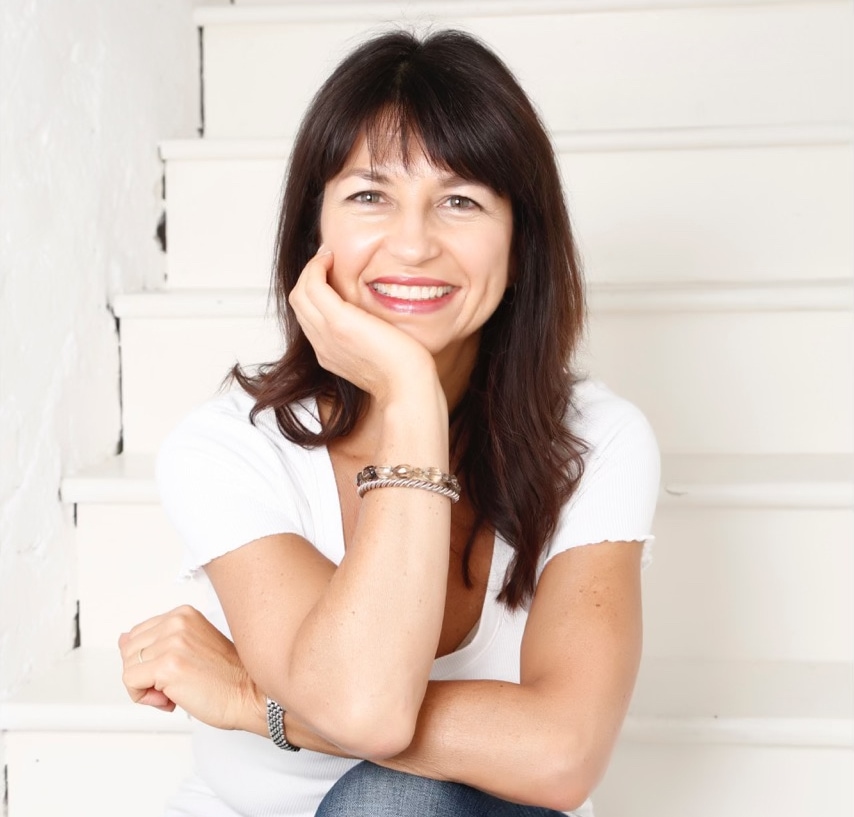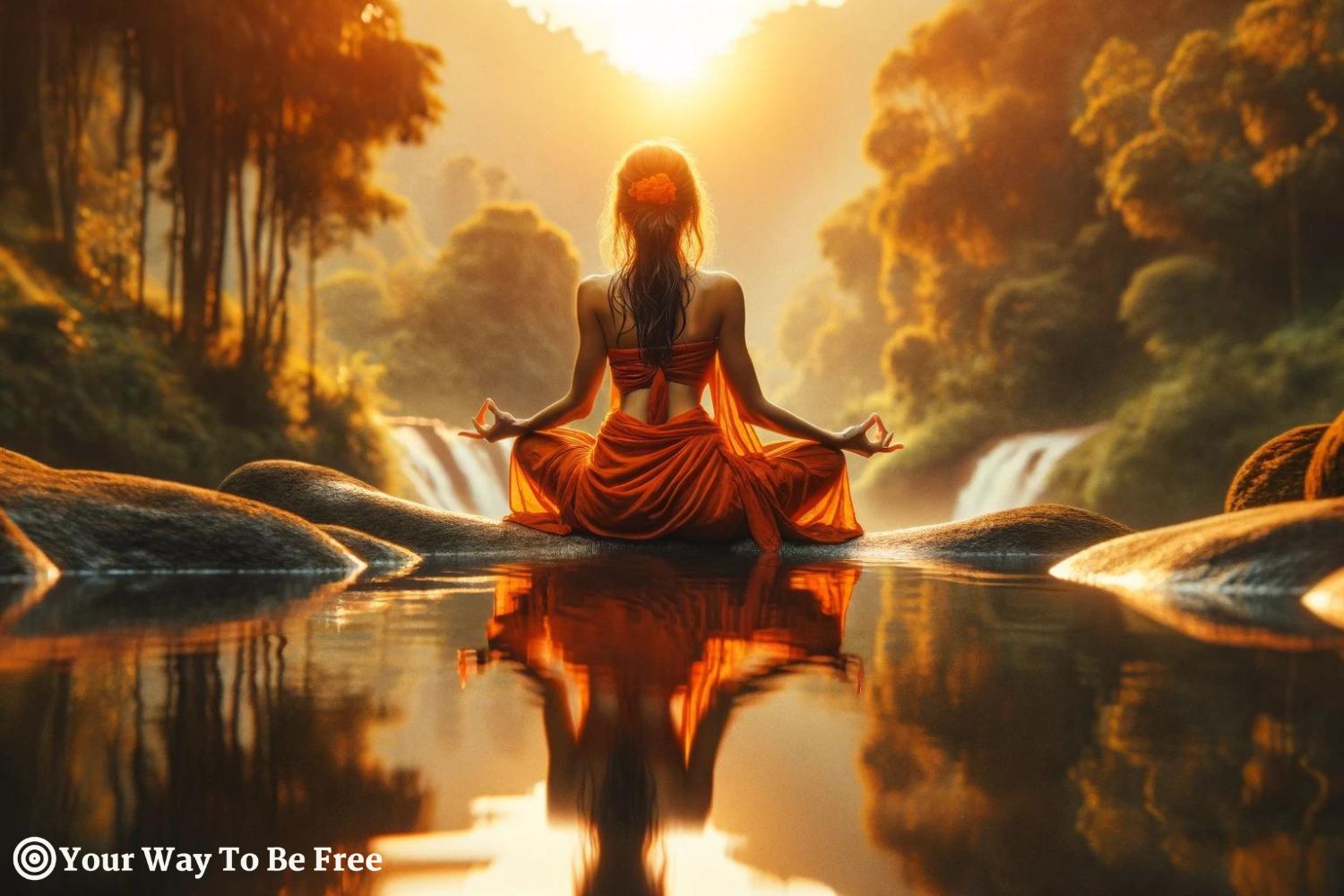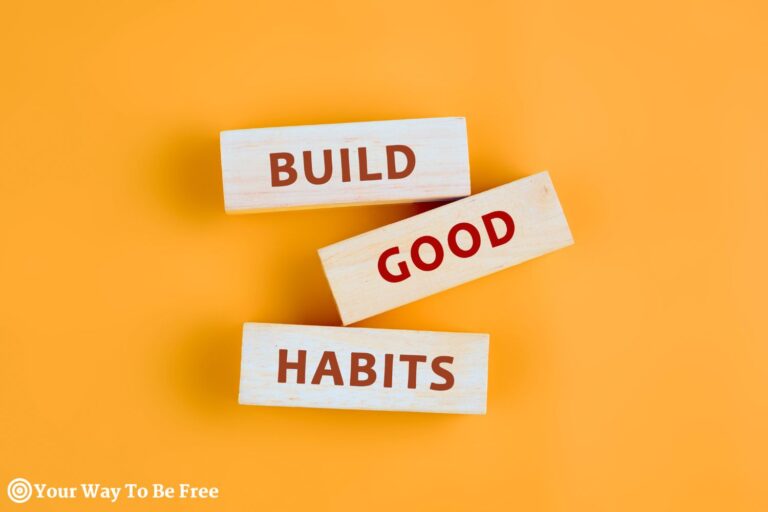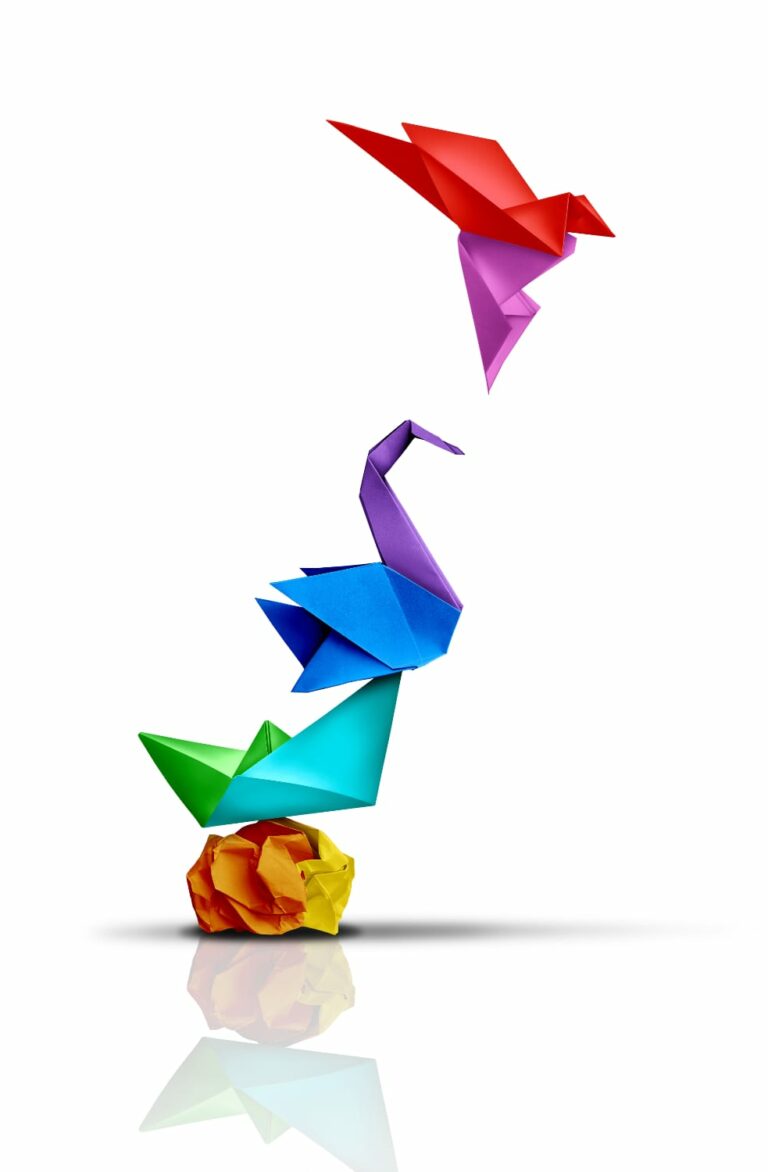Introduction to the Sacral Chakra
Have you ever felt overwhelmed by your emotions or stifled in your creative expression? In our structured and often stressful society, it’s common to feel detached from our emotional selves and our innate creativity. This article delves into the Sacral Chakra, a crucial energy center that influences our feelings, relationships, pleasure, and creativity. By understanding and nurturing the Sacral Chakra, you can enhance your emotional depth, foster healthy relationships, and unlock your creative potential. Join me as we explore this vibrant chakra and learn how to unlock a more vibrant, connected, and joyful existence.
Understanding the Sacral Chakra's Role and Location
The sacral chakra is located in the lower abdomen between the navel and genitals, although it encompasses the whole section of the body between these two points. It corresponds to the nerve ganglion called the sacral plexus. This plexus hooks into the sciatic nerve and is the centre of motion for the body.
The element of this chakra is water and therefore it corresponds to bodily functions associated with liquid, circulation of the blood, urinary elimination, sexuality, reproduction and qualities of water such as flow, formlessness, fluidity and surrender.
The chakra is the centre of sexuality as well as emotions, sensation, pleasure, movement and nurturing. In the Kabbalistic tree of life, the chakra relates to the Yesod, the sphere of water and the moon. The moon pulls the oceans of water to and fro in a dualistic rhythmic motion.
‘You are the water – the essence of all forms, yet formless. You are the point from which each direction flows, and you are the flow. You are the one that feels, you are the one that moves. You are the one that embraces the other.’ – Anodea Judith
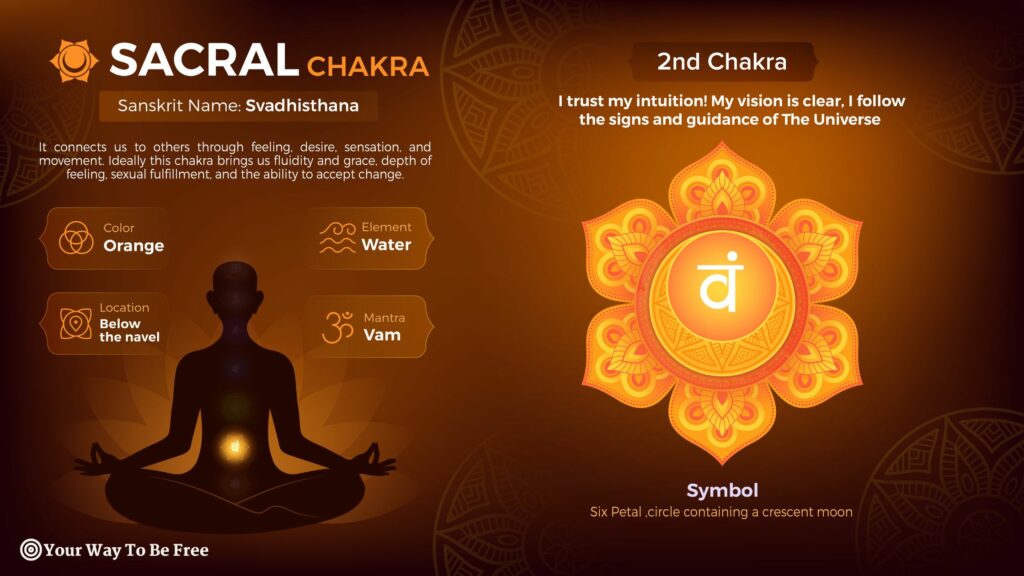
Symbolism and Connectivity
In Sanskrit, the chakra is called Svadhisthana, usually translated as ‘one’s own abode’ from the root ‘sva’ meaning ‘one’s own’. It is also in the root ‘svad’ meaning to taste sweet, to enjoy or take delight. When a plant has deep roots and is well watered then the fruit is sweet. The Tantric symbol for Svadhisthana has six petals with two more lotuses within. At the base of the middle lotus is a crescent moon and a Makara, an alligator creature with a coiled tale like the coil of the kundalini. He is a water creature representing consuming desire and passions that must be harnessed to move onwards.
Energy Flow and Balance
The chakras are connected by the Sushumna, a non-physical channel running up the center of the body. Two alternate channels control the yin and yang energies, Ida and Pingala, twisting in the figure eight patterns around each chakra running alongside the Sushumna. These channels are among thousands of subtle energy channels called ‘nadis’ meaning ‘flowing water’. Ida and Pingala represent the lunar and solar aspects respectively.
Movement and flow along these nadis contribute to the spinning of the chakras. For example, as energy flows upwards to the right nostril through the Pingala, there is directional flow around each chakra complemented by its opposite a downward energy on the other side of the chakra flowing through the Ida. The two movements turning in opposite directions around each side of the center cause the chakras to spin.
The crossing of the nadis between the chakras makes each center spin in an opposite direction to the one above and below. As each chakra spins in an opposite direction the chakras form a sinuous movement of subtle energy up and down the spine.
Yin and Yang Integration
The concepts of Yin and Yang also apply to the chakras themselves. The sacral chakra is yin with more feminine qualities of receptivity, emotions and nurturance and bearing new life. Water is receptive adopting the shapes of what it encounters, following the path of least resistance, yet gaining power and momentum as it flows. The sacral chakra is related to the moon. The moon rules the unconscious, the mysterious, the unseen, the dark and the feminine.
The Pleasure Principle
Pleasure and emotional sensations are processed in the limbic system that controls the hypothalamus which in turn controls the hormonal levels and the regulation of the autonomic (involuntary) nervous system functions such as heart rate, blood pressure, and breathing. Soothing stimulation to this part of the brain helps regulate and relax these hormones and processes.
Pleasure invites us to expand, whilst pain generally makes us contract. Pleasure helps the mind and body to establish better communication, relax, and release tension. Then impulses can flow freely through the whole body, without fear of suppression, and gradually create rhythmic, coherent patterns soothing to the whole nervous system.
Sensation is a valuable information source for all levels of consciousness. It provides the raw data that eventually becomes information, stored and analyzed by the brain. Ignoring bodily sensations cuts us off from the valuable information that plays a part in transferring information to the brain and moving energy through the body. Sensations are the building blocks of our feelings and emotions.
Emotions promote the evolution of consciousness through the body. When we feel emotions, we are moving energy out of the unconsciousness, through the body into the conscious mind. The flow of consciousness charges the body, cleanses it, and heals it. It is the movement of our life force through which we achieve change.
It takes energy to repress emotion so releasing emotions releases tension (if done appropriately). The absence of tension creates a harmonious flow within the mind and body. The suppression of primary pleasures creates a need for overindulgence turning pleasure into pain. Pain is an indication that we are going in the wrong direction.
The suppression of pleasure creates deprivation in the body that demands too much attention. Only through appropriate satisfaction and resolution can our awareness evolve safely.
Self-Nurturance and the Importance of Touch
Nurturing is a fundamental need of the body – it means caring for, feeding with energy love, and touch. It is the essence of maternal qualities, warmth, and security. The simple act of touching is very important for the functioning of a human. The skin is the outer layer of our nervous system and the boundary of our body. Through touch that boundary is broken down and permeated by another and our whole internal system is enhanced and stimulated.
Studies have found that babies given more touching and mothering have a greater emotional stability than those who are deprived. Without touch, important mind/body interfaces may remain undeveloped. Nurturance helps control the production of hormones responsible for growth by stimulating the limbic part of the brain. This also helps relaxation of the heart and breathing rate controlled by the autonomic nervous system.
Clairesentience
Clairesentience is the psychic sense of sacral chakra, it is the ability to sense other people’s emotions also called empathy. It is a valuable source of information and helpful in the development of psychism. Grounding helps if one is too clairsentient. Knowing the difference between your own and other’s emotions is important. Awareness of the other should be balanced by awareness of the self.
Natural Remedies for the Sacral Chakra
- HERBS: Berberis, Dandelion root, Cleavers (kidney support), Agnus Castus (hormonal balance), Uva Ursi (UTIs), Black Cohosh (menopause), Yarrow (hemorrhages).
- HOMEOPATHY: Sepia, Lachesis, Nar Mur, Pulsatilla, Nux Vom, Staphisagria, Arsenicum, Aconite, Calc Carb (female hormonal remedies) Apis, Causticum, Cantharis, Equisitium, Sarsparilla (bladder/urinary support).
- FLOWER ESSENCES:
- Bush essences ‘Flannel Flower’ and ‘She Oak’: to help fertility.
- Bach essence ‘Rock Water’: purist, rigid, remedy brings broader outlook, understanding
- Bach ‘Walnut’: for stages of transition and development, the ‘link breaker’.
Recommendations
- Bathing in water, use rose petals and rose essential oil (diluted in milk) in the bath.
- Try more dancing, yoga, and other movement
- Self care, self-massage, self nurturing.
- Massage the abdomen using oils, stroke up the right side, across, and down the left side.
- Focus on your relationships, notice your connection with others
- Take notes of moments of stillness and the quality of your movement throughout your day.
Conclusion: Embracing the Flow of the Sacral Chakra
In navigating the depths of the Sacral Chakra, we unlock the doors to our intrinsic emotional and creative realms. As we nurture and balance our Sacral Chakra, we enable ourselves to flow more harmoniously with life’s currents, embracing our ability to experience pleasure, engage with our creative impulses, and connect deeply with our own essence and those around us.
Through the practices, remedies, and insights shared, you are equipped to foster a healthier, more vibrant Sacral Chakra, enhancing your emotional well-being and enriching your life. Remember, the journey to understanding and nurturing your chakras is ongoing—a beautiful process of growth, discovery, and transformation. Embrace this journey to a more vibrant and connected self, where every emotion and creative impulse is acknowledged and celebrated.
Reading and Resources
- ‘Wheels of Life’ by Anodea Judith
- ‘Eastern Body, Western Mind’ by Anodea Judith
- ‘Women Ripening through the Menopause’ by Melissa Assilem (highly recommended including mythology and remedies for the menopause)
Related: The Power of the 7 Chakras
Explore the fascinating world of the 7 chakras and unlock the secrets to balancing your mind, body, and spirit. Learn how each chakra influences your well-being, from the grounding energy of the Root Chakra to the divine connection of the Crown Chakra. Embrace the journey towards harmony and inner peace by understanding these vital energy centers.
- 1st Chakra: Root Chakra
- 2nd Chakra: Sacral Chakra (Current article)
- 3rd Chakra:Solar Plexus Chakra
- 4th Chakra: Heart Chakra
- 5th Chakra: Throat Chakra
- 6th Chakra: Third Eye Chakra
- 7th Chakra: Crown Chakra
